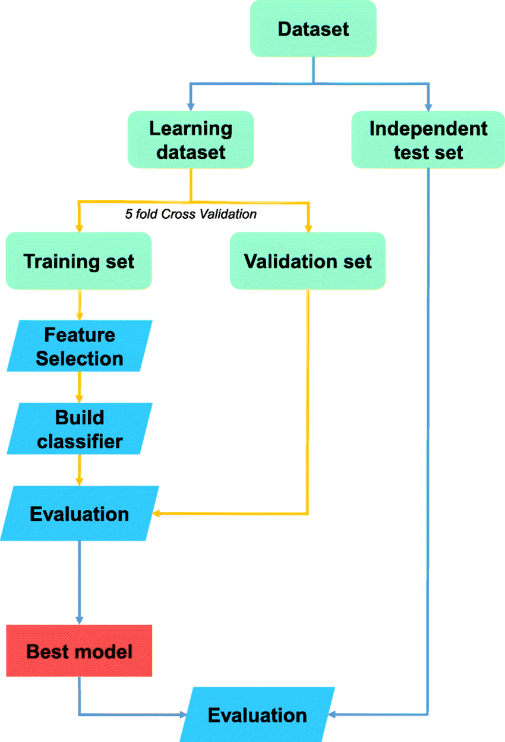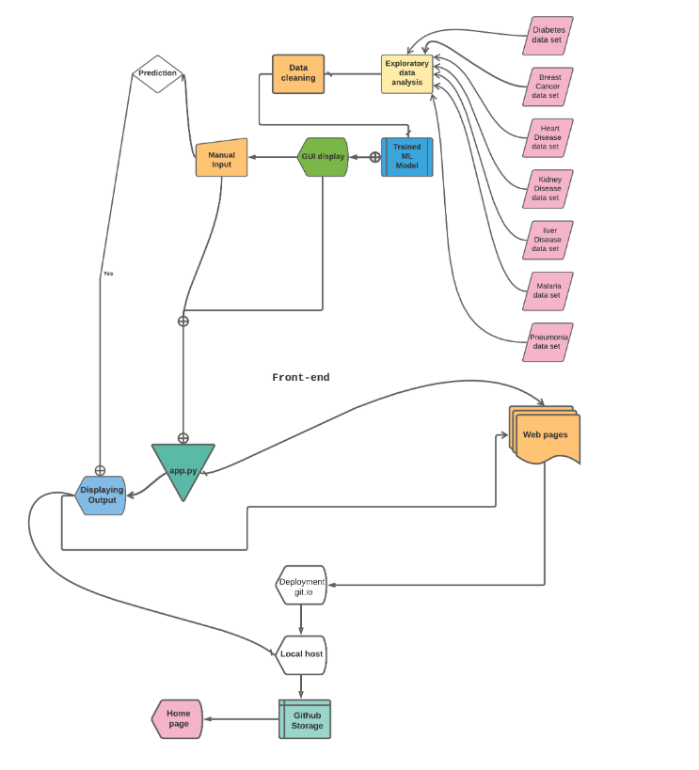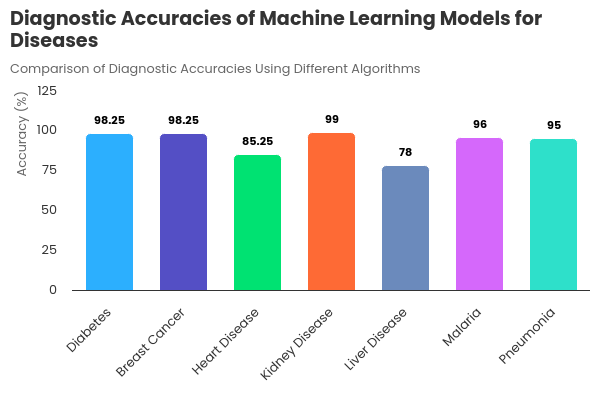Ijraset Journal For Research in Applied Science and Engineering Technology
- Home / Ijraset
- On This Page
- Abstract
- Introduction
- Conclusion
- References
- Copyright
Smart Machine Learning Analysis and Blockchain Healthcare Platform
Authors: Dr. Jayalakshmi Murugan, Sai Viswas Basetti, Kiran Kumar Bandi, Lakshmi Indrasena Reddy Bandi, Malleswari Batta
DOI Link: https://doi.org/10.22214/ijraset.2024.65015
Certificate: View Certificate
Abstract
The Smart Machine Learning Medical Analysis and Blockchain Healthcare Platform (SMLMAP) represents a transformative approach to medical diagnostics and data management by integrating advanced machine learning algorithms with blockchain technology. This platform is designed to accurately diagnose seven critical diseases, achieving impressive diagnostic outcomes across various conditions, including diabetes, breast cancer, heart disease, kidney disease, liver disease, malaria, and pneumonia. SMLMAP employs Random Forest algorithms for text data analysis and Convolutional Neural Networks (CNNs) for image data, ensuring rapid and precise diagnostic results. In addition to enhancing diagnostic capabilities, SMLMAP addresses significant privacy and security concerns inherent in healthcare data management. The integration of blockchain technology facilitates secure, transparent, and tamper-proof storage of patient records, empowering individuals with greater control over their medical information. This dual approach not only improves the accuracy of diagnoses but also fosters trust between patients and healthcare providers by safeguarding sensitive data against unauthorized access. Key functionalities of SMLMAP include the ability to schedule doctor appointments conveniently through the platform, ensuring that patients can receive timely medical attention. Additionally, the application provides users with a weekly healthcare magazine, delivering valuable information on health tips, disease management, and wellness advice to promote informed health decisions. By leveraging the strengths of machine learning and blockchain, SMLMAP paves the way for a more efficient, accurate, and secure healthcare ecosystem. This innovative platform not only enhances the quality of medical diagnostics but also represents a significant step forward in addressing the critical challenges of data privacy and security in the healthcare sector. The findings underscore the potential of SMLMAP to revolutionize patient care and data management in the evolving landscape of healthcare technology.
Introduction
I. INTRODUCTION
In the rapidly evolving landscape of healthcare, the integration of advanced technologies such as machine learning (ML) and blockchain is becoming increasingly essential. The Smart Machine Learning Medical Analysis and Blockchain Healthcare Platform (SMLMAP) exemplifies this integration, addressing critical health challenges while aligning with the United Nations Sustainable Development Goals (SDGs), particularly SDG 3, which aims to ensure healthy lives and promote well-being for all, and SDG 9, which focuses on building resilient infrastructure and fostering innovation.
SMLMAP leverages sophisticated machine learning algorithms to enhance medical diagnostics, enabling accurate and timely identification of various diseases. By employing techniques such as Random Forest and Convolutional Neural Networks (CNNs), the platform achieves remarkable diagnostic accuracies for conditions like diabetes, breast cancer, and pneumonia, among others. This capability not only improves patient outcomes but also contributes to the overarching goal of SDG 3 by facilitating early detection and intervention, thereby reducing morbidity and mortality rates associated with preventable diseases(Latif et al., 2020, p. 1).Moreover, SMLMAP incorporates blockchain technology to ensure the secure and transparent management of electronic health records (EHRs). This integration addresses significant privacy and security concerns prevalent in healthcare, as traditional systems often face vulnerabilities such as data breaches and unauthorized access(Ajayi et al., 2020, pp. 1–2). By providing a tamper-proof and decentralized framework for EHR exchange, SMLMAP enhances the integrity and confidentiality of patient data, fostering trust between patients and healthcare providers. This aligns with SDG 9 by promoting resilient infrastructure that supports secure data management and encourages innovation in healthcare delivery(Ajayi et al., 2020, p. 2).
In addition to its diagnostic and security functionalities, SMLMAP enhances user experience through features such as convenient appointment scheduling and real-time updates on hospital resources. These functionalities empower patients to make informed decisions regarding their healthcare, further promoting health literacy and engagement(Kumar et al., n.d., pp. 1–3). By providing a comprehensive platform that integrates ML and blockchain, SMLMAP not only addresses immediate healthcare needs but also contributes to the long-term sustainability and resilience of healthcare systems, making it a vital tool in the pursuit of the SDGs.
II. LITERATURE REVIEW
A. Role of Machine Learning Algorithms in Medical Diagnosis
Machine learning (ML) algorithms have significantly enhanced diagnostic accuracy and efficiency in healthcare. Image-based analysis using ML, such as the application of deep learning models to X-rays and MRIs, has shown promising results in accurately identifying diseases. For instance, the integration of deep learning models like Convolutional Neural Networks (CNNs) with blockchain technology has been proposed to securely transmit and diagnose medical images, achieving high classification performance with sensitivity, specificity, and accuracy metrics[7].Additionally, hybrid deep learning techniques combining traditional ML approaches have been utilized for real-time analysis of large-scale healthcare data, facilitating timely diagnosis and treatment recommendations[2].
Text data-based disease prediction and symptom-based disease prediction are other areas where ML has made significant strides. For example, Naive Bayes classifiers have been used to predict diseases based on medical symptoms provided by patients, achieving high accuracy rates[5].Support Vector Machines (SVMs) have also been employed to analyze healthcare data, demonstrating superior performance compared to conventional classifiers[9].
B. Implementation of Blockchain Technology for Secure Patient Data Management
Blockchain technology (BCT) offers a decentralized and transparent framework for secure data storage, sharing, and access control in healthcare. By integrating blockchain into healthcare systems, data integrity, privacy, and interoperability can be ensured while eliminating the reliance on centralized authorities[2].Blockchain's decentralized database provides extreme privacy to patient health records, making it a reliable platform for managing sensitive health information[5].
Blockchain has been applied to various aspects of healthcare, including electronic health records (EHRs) and electronic medical records (EMRs) management, ensuring data privacy and security[1][3]. The use of blockchain in healthcare also addresses issues related to data integrity and fraud prevention, enhancing the overall efficiency of healthcare systems[3].
C. Integration of Machine Learning and Blockchain in Healthcare Platforms
The integration of ML and blockchain within healthcare platforms offers both predictive medical analysis and secure data management. For instance, a permissions-based blockchain framework combined with hybrid deep learning models ensures that only authorized entities can access and modify sensitive health information, preserving patient privacy while facilitating seamless data sharing and collaboration among healthcare providers[2]. This integration enables real-time analysis of healthcare data, improving diagnostic accuracy and treatment recommendations[2].
Moreover, federated learning (FL) combined with blockchain technology has been proposed to overcome privacy, ownership, and regulatory challenges associated with centralized data storage. This approach allows for the decentralized management of clinical data, enhancing security and privacy in smart healthcare systems[1].
D. Contribution to Sustainable Development Goals (SDGs)
The application of ML and blockchain technologies in healthcare contributes to the achievement of Sustainable Development Goals (SDGs), particularly SDG 3 (Good Health and Well-being) and SDG 9 (Industry, Innovation, and Infrastructure). By improving diagnostic accuracy and efficiency, these technologies enhance patient outcomes and overall health and well-being[10]. The secure management of patient data through blockchain technology ensures data privacy and integrity, fostering trust in healthcare systems and promoting innovation in the healthcare industry[4].
Furthermore, the integration of these technologies supports the development of scalable and secure healthcare systems, addressing the challenges of data privacy and security in the era of big data and IoT[4]. This aligns with the goals of SDG 9, which emphasizes the importance of building resilient infrastructure and fostering innovation.
E. Conclusion
The integration of machine learning and blockchain technology in healthcare has the potential to revolutionize medical diagnosis and secure patient data management. By leveraging the strengths of both technologies, healthcare systems can achieve higher diagnostic accuracy, enhanced data security, and improved patient outcomes. These advancements contribute to the achievement of Sustainable Development Goals, promoting good health and well-being, and fostering innovation in the healthcare industry.
III. SYSTEM ARCHITECTURE AND METHODOLOGY
The architecture of the machine learning-powered medical diagnosis platform integrates advanced technologies to ensure secure patient records and efficient diagnostics. The system comprises three primary layers: the frontend, backend, and blockchain layer.
- Frontend: The user interface is developed using HTML, CSS, and JavaScript frameworks like React. This layer allows patients and healthcare providers to interact with the system, schedule appointments, and view diagnostic results. The frontend communicates with the backend through RESTful APIs, ensuring a seamless user experience.
- Backend: The backend is built using Python, which hosts the machine learning models for diagnosing various medical conditions. It utilizes frameworks like Flask or Django to handle API requests and manage data. The backend connects to a database for storing patient information and diagnostic results. Additionally, Node.js can be employed for real-time data processing and handling concurrent requests.
- Blockchain Layer: This layer employs Solidity for developing smart contracts that manage patient records securely. The blockchain ensures that all patient data is encrypted, tamper-proof, and accessible only to authorized users, enhancing data privacy and security(Abbas et al., 2022; Ma et al., 2020; Miah et al., 2022, pp. 1–6).
The connection between the frontend and backend is facilitated through the app.py file, which serves as the main entry point for API requests. It routes incoming requests to the appropriate backend services, processes the data, and returns responses to the frontend, ensuring a cohesive and secure user experience. This architecture not only enhances diagnostic accuracy but also addresses critical privacy concerns in healthcare.

Figure 1: The Process work flow
In the methodology section, we employ Random Forest for text data analysis, leveraging its ensemble learning approach to construct multiple decision trees for improved accuracy and robustness. The model is trained on a diverse dataset, utilizing bootstrapping and feature randomness to enhance generalization and reduce overfitting(Salman et al., 2024; Xing et al., 2022).
For image data analysis, we utilize Convolutional Neural Networks (CNNs), which excel in extracting hierarchical features from images through convolutional and pooling layers. The CNN is trained using backpropagation and gradient descent, optimizing the loss function to ensure high accuracy in diagnosing medical conditions from imaging data(Novikova et al., 2022; Xu et al., 2024).

Figure 2: The Machine Learning model Training Steps
IV. RESULTS
The healthcare platform leverages machine learning algorithms to predict diseases based on patient symptoms and medical images, demonstrating impressive diagnostic capabilities across seven diseases. The performance metrics for each disease are as follows:
- Diabetes: Achieved an accuracy of 98.25%, indicating a high level of reliability in diagnosing this condition.
- Breast Cancer: Also recorded an accuracy of 98.25%, showcasing the platform's effectiveness in identifying this critical disease.
- Heart Disease: The accuracy for heart disease diagnosis was 85.25%, reflecting a solid performance, though slightly lower than the other conditions.
- Kidney Disease: Achieved an impressive accuracy of 99%, highlighting the platform's capability in detecting renal issues.
- Liver Disease: The accuracy for liver disease diagnosis was 78%, indicating room for improvement in this area.
- Malaria: Recorded an accuracy of 96%, demonstrating strong performance in identifying this infectious disease.
- Pneumonia: Achieved an accuracy of 95%, indicating effective detection capabilities.
The platform utilizes Random Forest for text data analysis, which is particularly effective for structured data, and Convolutional Neural Networks (CNNs) for image data analysis, excelling in tasks involving medical imaging. These results underscore the platform's potential to enhance diagnostic accuracy and improve patient outcomes in healthcare settings.

Figure 3: The Disease prediction Accuracies
V. DISCUSSIONS
Integrating machine learning (ML) with blockchain technology in healthcare offers significant advantages for secure and rapid medical analysis. Traditional healthcare systems often rely on centralized databases, which are vulnerable to data breaches and inefficiencies in data sharing. In contrast, platforms like the Smart Machine Learning Medical Analysis and Blockchain Healthcare Platform (SMLMAP) utilize decentralized blockchain to ensure data integrity and patient privacy while employing ML algorithms for accurate diagnoses. This integration aligns with Sustainable Development Goal 3 (SDG 3) by enhancing healthcare access and quality, particularly in low-resource settings where timely medical interventions are critical.
SMLMAP demonstrates superior diagnostic accuracy compared to traditional systems, leveraging ML to analyze symptoms and medical images efficiently. The use of blockchain not only secures patient data but also facilitates interoperability among healthcare providers, fostering a collaborative environment for patient care. However, challenges remain, including the complexity of model training and the need for patient education to encourage adoption.
Despite These Limitations, The Potential For Future Work Is Vast. Expanding The Model To Include Additional Diseases And Integrating Ai For Predicting Treatment Outcomes Could Further Enhance Its Utility. Additionally, Addressing Barriers To Patient Adoption Through User-Friendly Interfaces And Educational Initiatives Will Be Crucial For Maximizing The Impact Of This Technology. By Overcoming These Challenges, The Integration Of Ml And Blockchain Can Revolutionize Healthcare Delivery, Ensuring Faster, More Accurate Diagnoses While Safeguarding Patient Information, Ultimately Contributing To Improved Health Outcomes Globally.
Conclusion
The Smart Machine Learning Medical Analysis and Blockchain Healthcare Platform (SMLMAP) significantly enhances healthcare diagnostics and data security by integrating machine learning and blockchain technologies. The research demonstrates that SMLMAP achieves high diagnostic accuracy across various diseases, including diabetes and breast cancer, utilizing advanced algorithms like Random Forest and Convolutional Neural Networks (CNNs). This capability not only improves the speed and precision of medical diagnoses but also empowers healthcare providers to make informed decisions based on real-time data analysis. Moreover, the incorporation of blockchain technology ensures secure, transparent, and tamper-proof storage of patient records, addressing critical privacy concerns prevalent in traditional healthcare systems. By enabling patients to control their medical information, SMLMAP fosters trust and enhances patient engagement in their healthcare journey. Overall, SMLMAP represents a transformative approach to modern healthcare, aligning with the goals of improving patient outcomes and ensuring data integrity. Future work should focus on expanding the platform\'s capabilities to include additional diseases and predictive analytics for treatment outcomes, further solidifying its role in advancing healthcare delivery. A. Contributions to SDG 3 (Good Health and Well-Being) • Improved Diagnostic Accuracy: SMLMAP facilitates early detection and timely medical interventions, ultimately enhancing patient outcomes. • Patient Empowerment: The platform\'s blockchain integration allows patients to manage their medical data securely, promoting trust and engagement. B. Contributions to SDG 9 (Industry, Innovation, and Infrastructure) • Promotion of Innovative Solutions: SMLMAP exemplifies the application of cutting-edge technologies in healthcare, transforming traditional systems into efficient, data-driven environments. • Infrastructure Development: The platform supports seamless data sharing among healthcare providers, enhancing the overall efficiency of healthcare delivery systems.
References
[1] Myrzashova, R., Alsamhi, S., Shvetsov, A., Hawbani, A., & Wei, X., 2023. Blockchain Meets Federated Learning in Healthcare: A Systematic Review With Challenges and Opportunities. IEEE Internet of Things Journal, 10, pp. 14418-14437. https://doi.org/10.1109/JIOT.2023.3263598. [2] Ali, A., Ali, H., Saeed, A., Khan, A., Tin, T., Assam, M., Ghadi, Y., & Mohamed, H., 2023. Blockchain-Powered Healthcare Systems: Enhancing Scalability and Security with Hybrid Deep Learning. Sensors (Basel, Switzerland), 23. https://doi.org/10.3390/s23187740. [3] Saeed, H., Malik, H., Bashir, U., Ahmad, A., Riaz, S., Ilyas, M., Bukhari, W., & Khan, M., 2022. Blockchain technology in healthcare: A systematic review. PLoS ONE, 17. https://doi.org/10.1371/journal.pone.0266462. [4] Fatoum, H., Hanna, S., Halamka, J., Sicker, D., Spangenberg, P., & Hashmi, S., 2020. Blockchain Integration With Digital Technology and the Future of Health Care Ecosystems: Systematic Review. Journal of Medical Internet Research, 23. https://doi.org/10.2196/19846. [5] W., & Patil, S., 2022. Implementing Blockchain Technology in Healthcare Systems utilizing Machine learning Techniques. 2022 IEEE North Karnataka Subsection Flagship International Conference (NKCon), pp. 1-7. https://doi.org/10.1109/NKCon56289.2022.10126874. [6] Tanwar, S., Bhatia, Q., Patel, P., Kumari, A., Singh, P., & Hong, W., 2020. Machine Learning Adoption in Blockchain-Based Smart Applications: The Challenges, and a Way Forward. IEEE Access, 8, pp. 474-488. https://doi.org/10.1109/ACCESS.2019.2961372. [7] Neelakandan, S., Beulah, J., Prathiba, L., Murthy, G., Raj, E., & Arulkumar, N., 2022. Blockchain with deep learning-enabled secure healthcare data transmission and diagnostic model. Int. J. Model. Simul. Sci. Comput., 13, pp. 2241006:1-2241006:16. https://doi.org/10.1142/s1793962322410069. [8] Miglani, A., & Kumar, N., 2021. Blockchain management and machine learning adaptation for IoT environment in 5G and beyond networks: A systematic review. Comput. Commun., 178, pp. 37-63. https://doi.org/10.1016/J.COMCOM.2021.07.009. [9] Patil, V., & Kalmani, V., 2023. Securing healthcare data management using machine learning and blockchain technology: A comparative performance evaluation of support vector machine and conventional classifiers. Journal of Statistics and Management Systems. https://doi.org/10.47974/jsms-1080. [10] Supriya, M., & Chattu, V., 2021. A Review of Artificial Intelligence, Big Data, and Blockchain Technology Applications in Medicine and Global Health. Big Data Cogn. Comput., 5, pp. 41. https://doi.org/10.3390/bdcc5030041. [11] Latif, J., Xiao, C., Tu, S., Rehman, S.U., Imran, A., Bilal, A., 2020. Implementation and Use of Disease Diagnosis Systems for Electronic Medical Records Based on Machine Learning: A Complete Review. IEEE Access 8, 150489–150513. https://doi.org/10.1109/access.2020.3016782 [12] Ajayi, O., Abouali, M., Saadawi, T., 2020. Secured Inter-Healthcare Patient Health Records Exchange Architecture, in: 2020 IEEE International Conference on Blockchain (Blockchain). Presented at the 2020 IEEE International Conference on Blockchain (Blockchain), IEEE, pp. 456–461. https://doi.org/10.1109/blockchain50366.2020.00066 [13] Miah, M., Sarwar, T.B., Islam, S.S., Haque, Md.S., Masuduzzaman, M., Bhowmik, A., 2022. An adaptive Medical Cyber-Physical System for post diagnosis patient care using cloud computing and machine learning approach, in: 2022 3rd International Conference for Emerging Technology (INCET). pp. 1–6. [14] Random Forest: A Complete Guide for Machine Learning | Built In [WWW Document], n.d. URL https://builtin.com/data-science/random-forest-algorithm (accessed 10.10.24). [15] Deep convolutional neural network based medical image classification for disease diagnosis | Journal of Big Data | Full Text [WWW Document], n.d. URL https://journalofbigdata.springeropen.com/articles/10.1186/s40537-019-0276-2 (accessed 10.10.24). [16] Sepreninova, Y., Makarenko, I., Plastun, A., Babko, A., Gasimova, G., 2020. Mapping Of The Responsible Investments Instruments In Sdg 3 ‘Good Health And Well-Being’ Financing: EU And US Experience. Health Economics and Management Review. [17] Dawson, S., 2021. SDG 3: Good Health and Well-Being. [18] Issues Paper on Using science, technology and innovation to close the gap on SDG 3, good health and well-being, 2021. [19] Alruwaili, F., Alabduallah, B., Alqahtani, H., Salama, A., Mohammed, G., & Alneil, A., 2023. Blockchain Enabled Smart Healthcare System Using Jellyfish Search Optimization With Dual-Pathway Deep Convolutional Neural Network. IEEE Access, 11, pp. 87583-87591. https://doi.org/10.1109/ACCESS.2023.3304269. [20] Neelakandan, S., Beulah, J., Prathiba, L., Murthy, G., Raj, E., & Arulkumar, N., 2022. Blockchain with deep learning-enabled secure healthcare data transmission and diagnostic model. Int. J. Model. Simul. Sci. Comput., 13, pp. 2241006:1-2241006:16. https://doi.org/10.1142/s1793962322410069. [21] Wang, S., Wang, J., Wang, X., Qiu, T., Yuan, Y., Ouyang, L., Guo, Y., & Wang, F., 2018. Blockchain-Powered Parallel Healthcare Systems Based on the ACP Approach. IEEE Transactions on Computational Social Systems, 5, pp. 942-950. https://doi.org/10.1109/TCSS.2018.2865526. [22] Lian, Z., Wang, W., Han, Z., & Su, C., 2023. Blockchain-Based Personalized Federated Learning for Internet of Medical Things. IEEE Transactions on Sustainable Computing, 8, pp. 694-702. https://doi.org/10.1109/TSUSC.2023.3279111. [23] Tagde, P., Tagde, S., Bhattacharya, T., Tagde, P., Chopra, H., Akter, R., Kaushik, D., & Rahman, M., 2021. Blockchain and artificial intelligence technology in e-Health. Environmental Science and Pollution Research International, 28, pp. 52810 - 52831. https://doi.org/10.1007/s11356-021-16223-0. [24] Fatoum, H., Hanna, S., Halamka, J., Sicker, D., Spangenberg, P., & Hashmi, S., 2020. Blockchain Integration With Digital Technology and the Future of Health Care Ecosystems: Systematic Review. Journal of Medical Internet Research, 23. https://doi.org/10.2196/19846. [25] Ahmed, I., Chehri, A., & Jeon, G., 2023. Artificial Intelligence and Blockchain Enabled Smart Healthcare System for Monitoring and Detection of COVID-19 in Biomedical Images.. IEEE/ACM transactions on computational biology and bioinformatics, PP. https://doi.org/10.1109/TCBB.2023.3294333. [26] Haddad, A., Habaebi, M., Islam, M., Hasbullah, N., & Zabidi, S., 2022. Systematic Review on AI-Blockchain Based E-Healthcare Records Management Systems. IEEE Access, 10, pp. 94583-94615. https://doi.org/10.1109/ACCESS.2022.3201878. [27] Shinde, R., Patil, S., Kotecha, K., Potdar, V., Selvachandran, G., & Abraham, A., 2022. Securing AI-based Healthcare Systems using Blockchain Technology: A State-of-the-Art Systematic Literature Review and Future Research Directions. ArXiv, abs/2206.04793. https://doi.org/10.48550/arXiv.2206.04793. [28] W., & Patil, S., 2022. Implementing Blockchain Technology in Healthcare Systems utilizing Machine learning Techniques. 2022 IEEE North Karnataka Subsection Flagship International Conference (NKCon), pp. 1-7. https://doi.org/10.1109/NKCon56289.2022.10126874. [29] Hashmani, M. et al. (2023). Blockchain in Healthcare: A Comprehensive Survey of Implementations and a Secure Model Proposal. Proceedings of the Pakistan Academy of Sciences: A. Physical and Computational Sciences. (Hashmani et al., 2023) [30] Westphal, E., & Seitz, H. (2021). Digital and Decentralized Management of Patient Data in Healthcare Using Blockchain Implementations. Frontiers in Blockchain. (Westphal & Seitz, 2021) [31] Reegu, F. et al. (2023). Blockchain-Based Framework for Interoperable Electronic Health Records for an Improved Healthcare System. Sustainability. (Reegu et al., 2023) [32] Chukwu, E., & Garg, L. (2020). A Systematic Review of Blockchain in Healthcare: Frameworks, Prototypes, and Implementations. IEEE Access. (Chukwu & Garg, 2020, pp. 21196–21214) [33] Al-Khateeb, M. et al. (2023). Blockchain-Based Framework for Interoperable Electronic Health Records for an Improved Healthcare System. Sustainability. (Reegu et al., 2023)
Copyright
Copyright © 2024 Dr. Jayalakshmi Murugan, Sai Viswas Basetti, Kiran Kumar Bandi, Lakshmi Indrasena Reddy Bandi, Malleswari Batta. This is an open access article distributed under the Creative Commons Attribution License, which permits unrestricted use, distribution, and reproduction in any medium, provided the original work is properly cited.

Download Paper
Paper Id : IJRASET65015
Publish Date : 2024-11-05
ISSN : 2321-9653
Publisher Name : IJRASET
DOI Link : Click Here
 Submit Paper Online
Submit Paper Online

